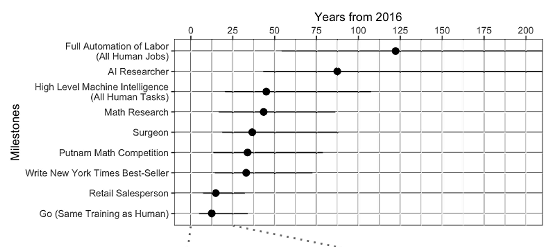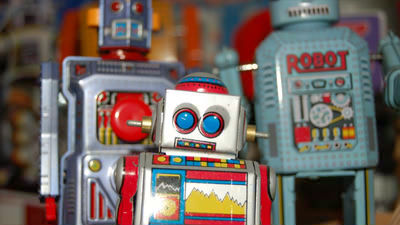When and when artificial intelligence overtakes humans in which field?
The prediction that machines work on behalf of human beings by AI's evolution is being done, but in concrete terms, it is said that "When will machines change into human labor force?", Scientists predict It was investigated. According to it, the machine which can interpret the language in 2024, the machine which can drive the truck in 2027, the machine which replaces the salesperson in 2031, the machine which can work as a surgeon in 2053 will come out.
[1705.08807v1] When Will AI Exceed Human Performance? Evidence from AI Experts
https://arxiv.org/abs/1705.08807v1
The subject of the survey was the year 2015NIPSWhenICMLThere were 352 scientists who made presentations on AI at academic conferences like. With these scientists as respondents, researchers said that with regard to matters such as "the ability to perform certain tasks such as folding laundry, interpreting languages" and "specific occupations such as truck drivers and surgeons" When is the timing beyond? And I asked questions about the impact of evolved AI on society.
First of all, in this survey, "that machines can perform all tasks better and cheaper than human workers without human hands" is called "High-level machine intelligence (high level machine intelligence / HLMI) "was defined as the word.
How long will it take for the HLMI to appear? As a result of aggregating the respondents' answers to the question, the probability of appearing within the next 45 years is 50%, but it turns out that the probability of appearing within the next 9 years is about 10%.
And some respondents also asked "When all machines of human beings can be fully automated, when will machines that can perform tasks better and cheaper than any human beings are born for every occupation?" However, the timing of the appearance of such machines was expected to be much later than when the HLMI performing individual tasks was realized. Specifically, the possibility of appearing by 122 years later is 50%, the possibility of appearing by 20 years is 10%.

For each occupation, the median timing when the probability of "AI beyond human beings" is 50% is as follows. In addition, the portion where the color of each graph is darker is the width of answer, the black dot is the median value.
From the top, the vertical axis is "fully automated for all occupations performed by humans" "AI researcher" "HLMI" "mathematics research" "surgeon" "Putnam mathematics competition" "write best seller of the New York Times" "salesperson" Go "and the horizontal axis shows from the left, from the year 2016 to the year of 12.5 years until 200 years later. Looking at the timing when AI is replaced by a human in each occupation, it is 122 years later that all the professions carried out by humans, AIs beyond AI researchers appear around 90 years, 43.4 years for mathematical researchers After, the surgeon is around 37 years later.

In addition, this is a graph showing details from 2016 to 30 years later. From the top, the vertical axis is "Salesperson" "Go" "Race between a biped robot and a human" "Track driver" "Top 40 pop music" "Explain your action in the game" "High school Writing essays on text "" To make texts a speech "" Complete all Atari games "" Can be assembled by any Lego "" Telephone banking operator "" Translation at a level that transcends amateur translators "" Speech notes "Starcraft"Fold the laundry" "World Series of Poker"angry birds"The horizontal axis is separated from the left from the year 2016 in 2.5-year increments.

Some scientists who became respondents thought that once the HLMI was realized, AI rapidly evolved and would be able to perform many human tasks. This phenomenon is called "intelligence explosion". The median probability that AI will be able to perform better all the tasks human beings perform better in 2 years after HLMI is realized is 10% and there is a possibility that a major breakthrough in technology will occur worldwide two years after HLMI The median is 20%.
Also, for the question of whether HLMI has a positive or negative influence on humans, the median probability of "to be a good result" is 25%, the probability of "very good results" The median of 20%, on the other hand, "10% is bad" and 5% "very bad" seems to have a relatively positive view. However, 48% of respondents believe that "research that minimizes potential hazards of AI should be given priority".
The time when HLMI is realized also varies depending on the area where respondents are conducting research. The vertical axis of the graph below shows the possibility of achieving HLMI, the horizontal axis shows from 2016 to 100 years later, the red graph is Asian researcher, the green graph is European researcher, the blue graph is The North American researcher, Purple graph shows the answer results from researchers in other areas. Regarding the feasibility of HLMI, researchers in Asia showed the most positive view, and researchers in North America seemed to tend to be less likely.

Related Posts:
in Science, Posted by darkhorse_log








